The 9 Best Core Exercises For Soccer Players
A strong core is essential for any athlete, regardless of sport, and this holds true for soccer players as well.
A strong core helps transfer power, aids in balance and it provides stability when engaged with another player. Not only is a strong and stable core important for improving game performance but it also plays an important role in injury prevention.
Soccer players inherently know this because when given ‘free time’ in the weight room they always do extra core work. (Or they’re just wanting to look good at the beach)
The issue I see all the time though is that most players do the same three or four core exercises over and over again. I believe we, as coaches, are guilty of this as well. We tend to program the same core exercises for our athletes that we’re familiar and comfortable with.
In this article, I’m going to try to help break you out of the monotony and give you eight of the best core exercises for soccer players so you’ll have plenty of fresh ideas for your next core workout.
Core Exercises For Soccer
What you may notice is the large majority of these core exercises focus on the low abs and heavily involve the hip flexors.
This is important for soccer players because the hip flexors are prime movers for kicking.
Toe Touches
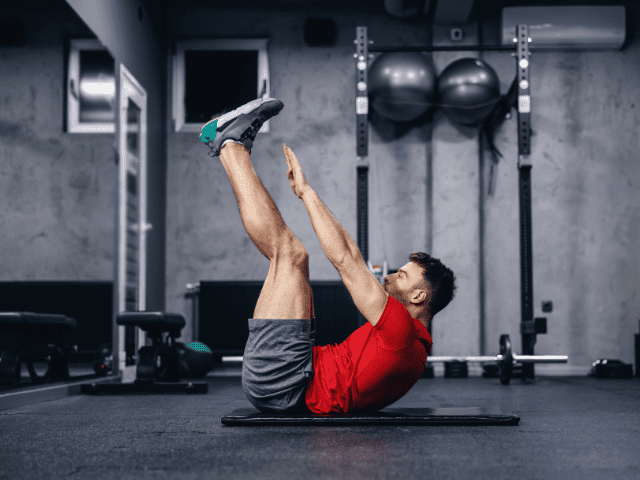
I know, Toe Touches is probably a core exercise that you’re already very familiar with. However, it is one of my favorite bodyweight core exercises for athletes.
Is it because having to hold your legs in the air makes the lower abs (and those hip flexors I just mentioned) have to work harder than regular crunches? Although that is a plus, that’s not the main reason.
Here’s why:
I love Toe Touches for soccer players because it gives me insight into who is extremely tight in their hamstrings. Players with really tight hamstrings will struggle to get into a proper position and will struggle even more to maintain it.
If this sounds familiar then it’s time to start addressing those hammies.
How To
- Lay flat on your back with your legs perpendicular to the floor (legs straight up in the air).
- From this position, keep your chin off of your chest, keep your arms straight and raise your upper body toward your feet.
- Touch your toes (or at least reach as high up your shins as you can) with your fingers and return to the starting position.
Coaching Points
Athletes with tight hamstrings may find it hard to keep their legs straight up in the air through the duration of the exercise. Work to keep legs straight and vertical as much as possible.
Keep hands relatively close to the shins throughout the movement. Swinging the arms toward the head at the bottom causes momentum which takes away from the quality of the movement.
Suitcase Crunches
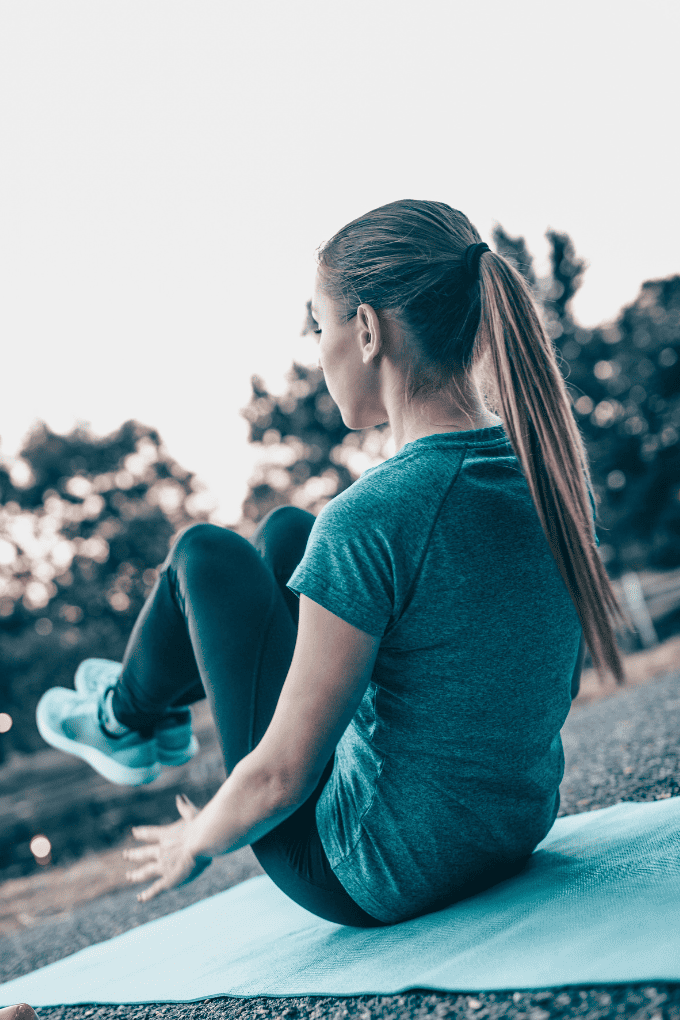
Next, let’s up the ante on the regular crunches that you’re probably already doing.
Suitcase Crunches are an advanced variation of regular crunches.
Step-by-Step Instructions
- Start by sitting on the ground, balancing on your butt with legs and back up off the ground.
- Legs should be almost straight, feet roughly six inches off the ground. Torso should be leaned back at about a 30-degree angle.
- From the starting position, crunch up, bringing the knees and chest together above the hips (like a suitcase shutting)
- Lower back to the starting position and repeat. (Feet and back should stay off the ground throughout the movement)
Coaching Points
If you keep your feet uncrossed during the movement, your groin will be forced to stay engaged. This creates a small added bonus to the exercise.
Planks
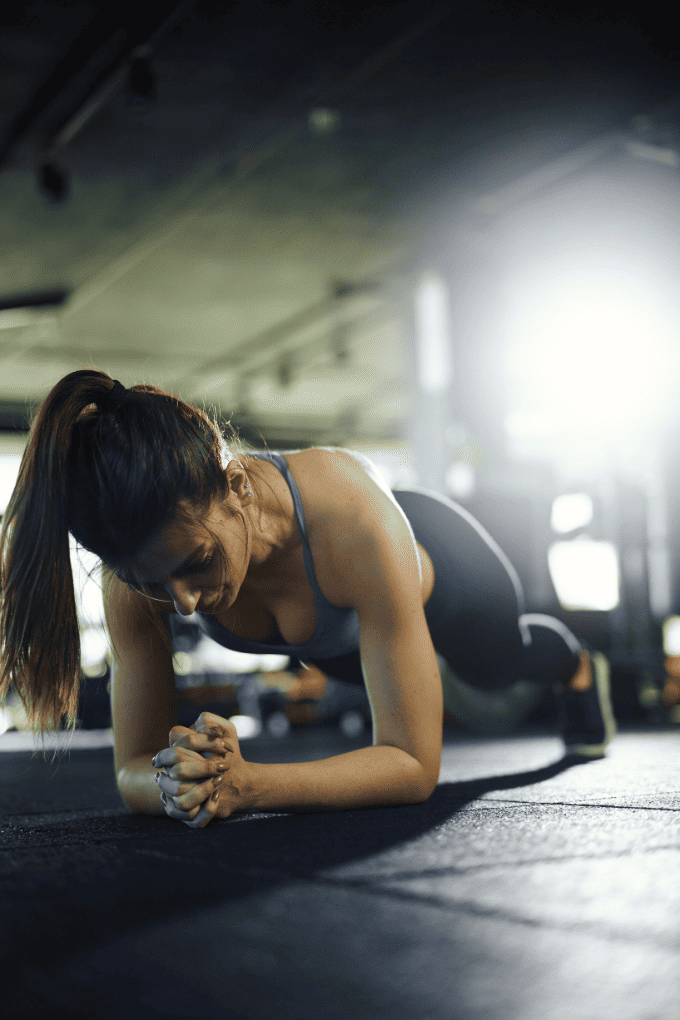
There are so many reasons that I love programming Planks for athletes, especially soccer players.
First, it teaches and reinforces what it means to brace your core. Knowing how to properly, and effectively, brace your core is so important not only in the weight room but on the soccer field as well.
Second, holding a plank can sometimes be as mentally challenging as it is physically challenging. I think anytime you can introduce situations (safely!) that get players out of their comfort zone and force them to strain is beneficial.
Finally, planks are extremely versatile. You can add weight or time to make them more challenging. You can switch to a side plank to incorporate more obliques and they also work great as a competition to finish a workout.
Step-by-Step Instructions
- Start on the ground on your stomach.
- Assume a push-up like position on your elbows and toes. Elbows should be directly under the shoulders.
- Position your body in a straight line from the shoulders through the hips, knees and ankles.
- Brace the core tight. (As if you’re going to be punched in the stomach)
- Do not let the body slouch to the ground nor push the hips up high in the air.
Coaching Points
The biggest mistake that I see with Front Planks is soccer players holding the position, but not properly keeping the core engaged and just allowing the torso to slouch.
So, while they are technically up on their elbows and toes, all they’re really doing is straining the low back.
The other mistake I see is the exact opposite and that is athletes shooting their butts into the air, resembling more of a Down Dog position.
The difference between the two is the second, having your butt too high, is easier to notice and corrected more often. However, letting the body slouch during a plank is often allowed to pass as ‘good form’ when it is not.
Need a Training Program?
Visit the Horton Barbell Shop and Use Code “HB10” for 10% Off ANY Program!
Medicine Ball Slams
Incorporating a Medicine Ball into your core routine is a great way to add resistance to some of the bodyweight exercises I’ve already listed (and another listed below).
Utilizing the ball in explosive movements to build power is why you want to add a med ball to your core training.

Med Ball Slams is the perfect example of a dynamic core exercise incorporating a medicine ball.
A Medicine Ball Slam is essentially utilizing your core to generate as much power as possible flexing at the torso and releasing that power in the form of slamming a med ball into the ground.
Step-by-Step Instructions
- Grab a medicine ball and stand tall with feet roughly shoulder-width apart.
- Reach the medicine ball high overhead.
- Using the core, pull the body down – hinging forward at the hips.
- Follow through with the arms and release the ball.
- Let the ball slam into the ground, catch it off the bounce and repeat for the designated number of reps.
Coaching Points
First and foremost, test how ‘bouncy’ your medicine ball is before starting. I can’t tell you how many times I’ve seen athletes almost have their face smashed by a medicine ball bouncing much harder and rebounding much faster off the ground than they were anticipating.
The biggest mistake I see with Med Ball Slams is athletes not utilizing the core and simply throwing the ball down with their arms.
The bulk of the force should be generated by aggressively using the core to hinge forward. If done correctly, it should almost (and actually might) lift your feet up off the floor.
Seated Med Ball Twist
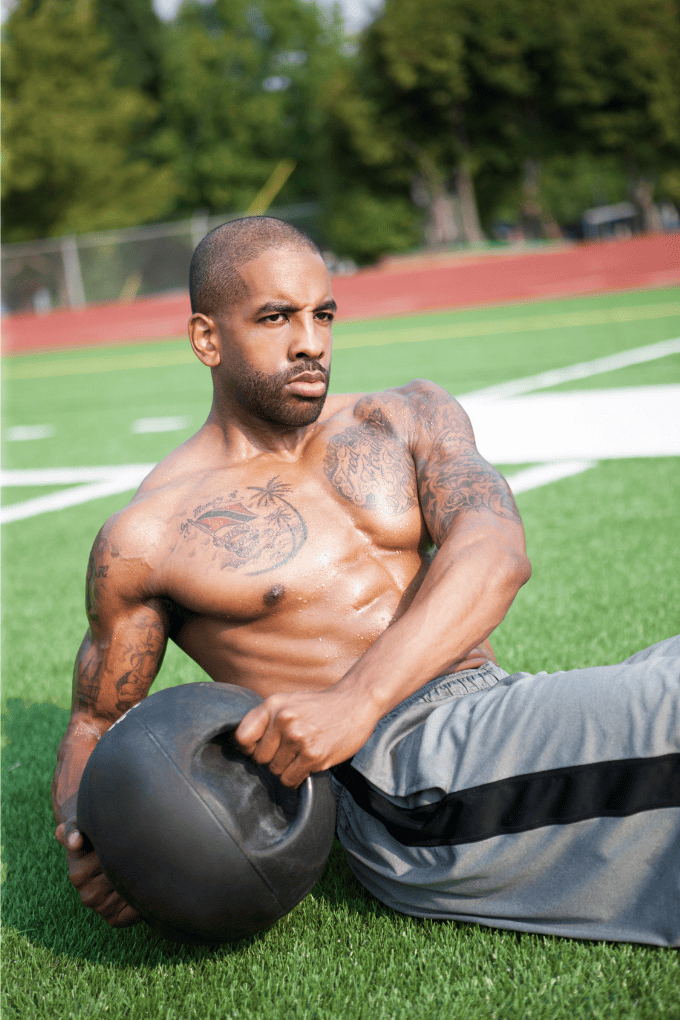
Seated Med Ball Twists help develop a strong core by forcing you to both stabilize – hold the seated position with feet up – as well as rotate through the core with resistance.
Step-by-Step Instructions
- Start by grabbing a medicine ball and taking a seat on the floor.
- Slightly bend the knees and raise your feet roughly six inches off the floor.
- Start by rotating your torso to the left and lightly tapping the med ball against the ground.
- Now turn your shoulders and rotate your torso to the right and, again, lightly tap the ball against the ground.
- Keep legs mostly still and maintain the feet off the floor throughout the movement.
Coaching Points (Common Mistakes)
The biggest mistake I see with my athletes when doing Seated Med Ball Twists is moving the ball back and forth primarily with their arms instead of rotating through the core.
The focus should be on the rotation.
Medicine Ball Side Toss

Med Ball Side Throw is another rotational core exercise utilizing a medicine ball. It’s essentially a more dynamic variation of the Seated Med Ball Twists that we just went over.
Find a sturdy wall or, better yet, a partner. Get in a good athletic position – feet shoulder-width apart and knees bent. Load the starting position by slowly rotating the ball to the back hip and then aggressively rotate and release the ball toward your partner.
I love Med Ball throwing movements like Slams and Side Tosses because of how much power players are able to generate. In fact, I like Side Throws so much that they’re also one of my favorite upper body exercises for soccer!
Step-by-Step Instructions
- Grab a medicine ball and stand perpendicular to a sturdy wall*.
- Distance away from the wall will vary based upon the type of medicine ball you have.
- Stand in a good athletic position, feet shoulder width apart, hips and knees bent.
- Begin by rotating away from the wall, reaching the medicine ball toward the back hip.
- Now, aggressively rotate toward the wall, turning on the ball of the back foot, opening the hips toward the wall and releasing the ball into the wall.
- Catch the ball off the ball, reset and repeat.
Coaching Points
The biggest mistake I see athletes make is using their arms (and not their hips) way too much to throw the ball. Power for the throw should primarily come from rotating the hips and torso and the arms should be secondary.
*If you have a partner, you can throw to each other instead of into a wall.
Hanging Straight Leg Raises

Hanging abs are some of my absolute favorite core exercises for soccer players.
Not only are they very challenging ab movements, but they also provide extra benefits as well. In addition to the core, most hanging ab movements also work the grip, shoulders, back and biceps.
Step-by-Step Instructions
- Find yourself a pull-up bar and grip the bar with an overhand grip.
- Engage your lats so your body doesn’t go limp once you begin to hang.
- Now hang from the bar and keeping your legs straight, drive them up to hip height (or slightly above hip height).
- Finally, actively lower your legs back to the starting position – don’t allow the legs to just swing down.
Coaching Points
The biggest issue that most athletes run into when doing Hanging Straight Leg Raises (or any hanging ab exercise for that matter) is how to keep from swinging out of control.
To keep from swinging, you have to actively lower your legs back down. If you ‘let your legs go’ and just allow gravity to take over you’ll completely lose control of the movement.
Windshield Wipers

One of the hardest core exercises to do, hands down, is Windshield Wipers. It takes a tremendous amount of core strength and will stress your entire core (and your hip flexors, upper body and grip… pretty much your entire body).
If you progress to the point where you can knock out a set of ten Windshield Wipers, you should feel pretty good about your core strength.
Step-by-Step Instructions
- Find yourself a pull-up bar and grip the bar with an overhand grip
- Engage your lats so your body doesn’t go limp once you begin to hang from the bar.
- Now hang from the bar with a slight flex at the elbow
- Keeping the legs straight, flex the core and lift the legs up until your toes touch the pull-up bar.
- From this position rotate your feet to the left about two to two and a half feet.
- Now swing them back to the top and over to the right about the same distance.
Coaching Points
This is an extremely challenging ab exercise. I would highly suggest mastering other hanging ab exercises like Knees to Elbows and Toes to Bar before beginning to attempt Windshield Wipers.
Because you’re almost hanging upside down while doing Windshield Wipers, the grip plays an extremely critical role. If you ever feel you’re struggling with your grip AT ALL, you should stop your set immediately.
Hyperextensions
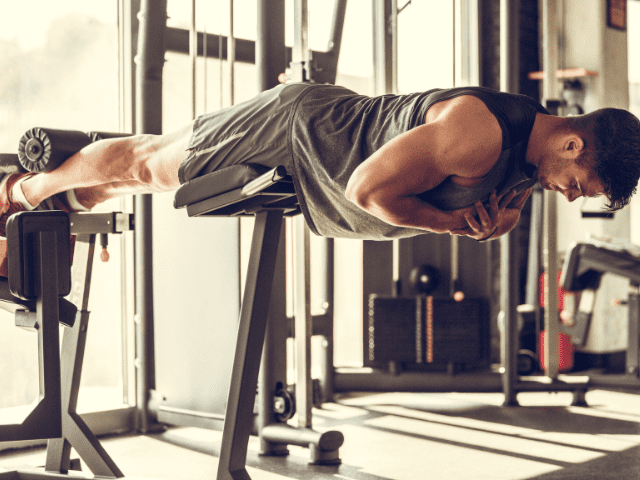
Too often when players think about doing ‘core work’ they only think of working their abs. However, low-back work is just as important, but it’s often either overlooked or just ignored.
Hyperextensions are one of the best movements you can do in a weight room to focus on building a strong low back. Hypers will also work the glutes and hamstrings as well.
If you don’t have access to a Glute Ham Machine, you can try either Supermans or Back Crunches. Both also work the low back and require no equipment.
Step-by-Step Instruction
- Position yourself on the hyperextension bench with your thighs against the pad and feet securely under the footplate.
- Cross your arms over your chest or place hands behind your head. Ensure your spine is neutral.
- Begin the exercise by bending at the hips, lowering your upper body toward the floor.
- Lower yourself as far as comfortable while maintaining a straight back.
- Lift your torso by extending your hips until your body forms a straight line from head to heels.
- Squeeze your glutes at the top of the movement, ensuring your back remains straight, not hyperextended.
- Slowly lower back to the starting position
Coaching Points
Hyperextensions are surprisingly easy to mess up. One of the easiest ways to make a mistake is going down too fast and “whipping” yourself back to the starting position.
It is important for the lifter to maintain a neutral spine, maintaining tension in the abdomen and upper back. Remember to breathe in and hold the breath during eccentric (lowering your body) and breathe out as you perform the concentric movement (bringing your body back up).
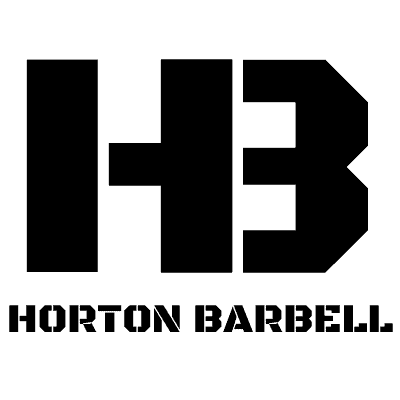
Need a Training Program?
Coach Horton has 20 years of experience training elite-level athletes at schools like the University of Tennessee and Georgia Tech.
Our Soccer Strength and Conditioning Program is an 8 Week, 4 Day-per-week program that is available on our Horton Barbell app.
Final Thoughts
There are dozens of core exercises that a soccer player can choose from so there is no need to get into a rut of doing the same movements over and over again all the time.
You also don’t have to limit yourself to just bodyweight abs, like crunches and sit-ups, either. Grab a medicine ball or find a pull-up bar and add some variety (and difficulty) to your core routine.
Finally, don’t forget about that posterior chain! Exercises like Hyperextensions, Supermans or even Back Crunches can help strengthen your low back – an important part of your core.

